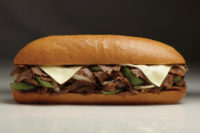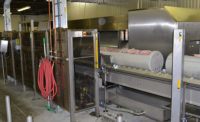The time between cooking and packaging is rife with potential for post-lethality contamination. Post-packaging pasteurization is a critical step in the food safety process to protect ready-to-eat (RTE) items during this time frame.
Hot water, steam, high-pressure processing (HPP), hot air, infrared heat, radiofrequency and irradiation are all different but useful methods for post-packaging pasteurization.
“For us, the rationale for HPP is very much skewed toward food safety intervention,” says Steven Burger, president of Burgers’ Smokehouse, in California, Mo. “The other benefits of HPP are that it allows us to take out chemical inhibitors and improve shelf-life extension.”
HPP is a non-chemical, non-thermal intervention method. “We use high pressure to kill pathogens, so we don’t negatively alter the product through the intervention,” Burger says.
Burgers’ Smokehouse also uses secondary inhibitors for extra protection when the package is opened by consumers or in an institutional environment. “So, the product gets initial protection from HPP and then a kicker on the back side,” Burger says.
In 2014, Burgers’ purchased its first HPP machine. “Due to the age of the machine and company growth, we are beginning discussions for another machine,” says Burger. “We use HPP two shifts a day, five days a week and one Saturday a month.”
Burgers’ has more than doubled the number of pounds it high-pressure processes over the last five years. The company uses HPP for cooked country ham, sugar-cured hams, all barbecue and smoked poultry — one-third of everything it produces. Two-thirds of Burgers’ products are uncooked or use the hot fill process, Burger says.
“With the advent of COVID-19 last year, our business-to-consumer side of the business grew tremendously,” Burger says. “So, when shipping through mail channels, it’s good to have extra food safety built into your product.”
Burgers’ was able to quickly pivot to the business-to-consumer channel last year, and sell to foodservice and retailers, because it could utilize HPP across all channels.
“I don’t see any hurdles with the existing technology,” says Burger. “The challenge is more through adopting a new technology or machine cost.”
Focused on food safety
West Liberty Foods is another company that has continually looked for avenues of differentiation and has focused on food safety as a guiding principle. “HPP also helps us protect the company’s and our customer partners’ brands,” says Joe Swanson, vice president of operations at the West Liberty, Iowa, company. “It enhances the shelf life of our products without the use of chemical preservatives and it is environmentally friendly, using only recycled water and electricity.”
West Liberty Foods processes uncured sliced deli meats, individual quick-freezing chicken items that are sold fresh versus frozen, items with clean labels and raw fresh ground turkey.
“The main advantages HPP has provided West Liberty Foods is the ability to have clean-label products that maintain the same physical attributes of color and flavor of non HPP-ed products,” Swanson says. “Currently approximately 20 percent of our business uses HPP post packaging pasteurization.”
The primary challenge West Liberty Foods has experienced with HPP is the added cost compared with other methods. “This has limited the products that can process using the method while remaining cost competitive,” Swanson says.
As RTE products continue to increase in popularity, post-packaging pasteurization systems will be an essential component of food safety interventions.
“I think the industry will see improvements in the efficiency of the (HPP) process and a reduction in the cost of consumable machine parts, which will help make the process more cost competitive,” Swanson says.




